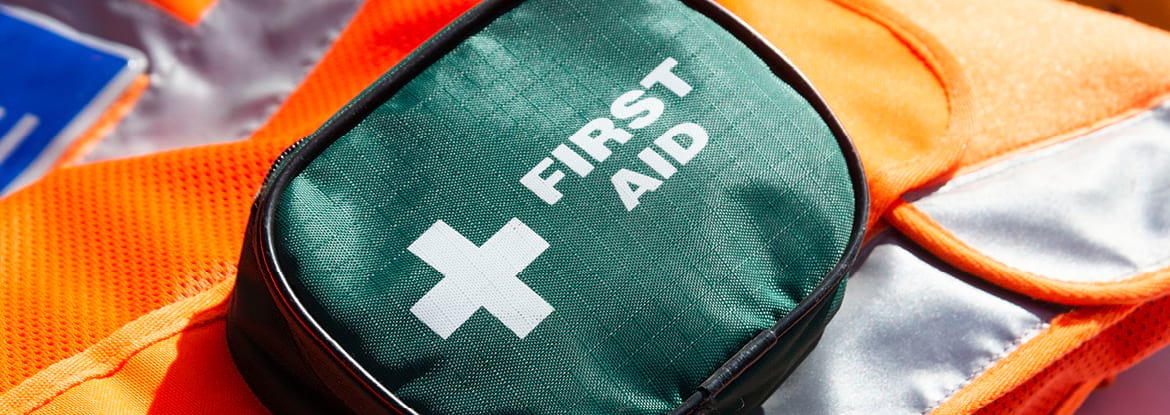Under the Work Health and Safety (WHS) Act, every workplace is required to have first aid equipment, kits, facilities and trained first aid personnel that suits the type of work being performed, the company size and location, the number of employees and the number of potential customers and/or visitors.
First Aid KitsAll first aid kits should include basic first aid equipment. When purchasing a first aid kit, you need to consider where and what the kit will service. Each first aid kit needs to be properly maintained and restocked, making sure that used items are replaced as soon as practically possible. During maintenance, any use by dates and item integrity should be checked to ensure that all items are in good working order. First aid kits must be:
Most first aid kits are available in metal, plastic or soft cases, so they can be personalised to suit the performance requirements of individual worksites. |
 |
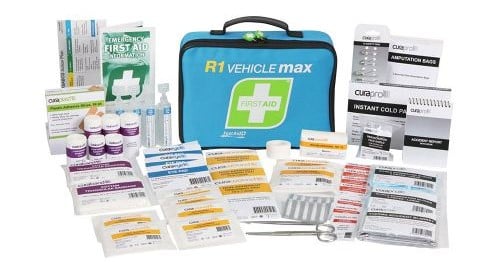 |
How to Pick a First Aid KitThe first step in picking a first aid kit is to determine the requirements of your workplace. For example, Fastaid has 4 different ranges to suit various workplaces.
|
The next step is to determine if your workplace is low risk or high risk.
Low-risk workplaces are any environment where employees are not directly exposed to any hazards that could potentially result in serious injury or illness, such as offices or shops. And, if an injury did occur, it would only require minor first aid. Whereas, high-risk workplaces are those that are exposed to hazards that could result in serious injury or illness, including:
- The use of hazardous machinery such as chainsaws, power presses or lathes.
- The use of hazardous substances such as chemicals, oils and gases.
- Working in confined spaces, demolition and welding.
- Workplaces with a threat to physical violence such as working alone at night or frequently dealing with aggressive people.
- Working in extreme heat and/or cold environments such as outdoor work.
The below graphic highlights how FastAid arrange first aid kit requirements into categories for easy selection.
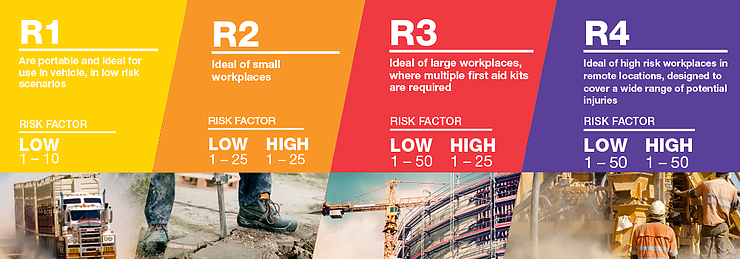
First Aid Equipment
Safe Work Australia's FirstAid Code of Practice states that at least one first aid kit and trained first aid representative is required at a workplace. Some workplaces should also have dedicated first aid rooms. A full workplace first aid assessment should be conducted to determine the number of first aid kits required at your workplace. Safe Work Australia provides a guide to help determine the type of first aid kit, the number of trained first aiders and first aid rooms, as well as any additional first aid equipment that may be required.
| Workplace | First Aid Kits | Trained First Aid Personnel | First Aid Rooms |
| Low Risk | Basic first aid kit | One for every 50 workers | Recommended for 200 workers or more |
| High Risk |
Basic first aid kit, plus:
|
One for every 25 workers | Recommended for 100 workers or more |
| Remote High Risk |
Basic first aid kit, plus:
|
One for every 10 workers | N/A |
First Aid Risk Assessment
A first aid risk assessment will help to determine the required contents of a first aid kit in your workplace, as every workplace has risk factors that can cause particular injuries or incidents due to the nature of work being undertaken. Request a first aid risk assessment today and a local ATOM Safety representative will assist you in implementing a tailored, fit for purpose first aid plan. This includes defining your workplace risk factor and determining what first aid equipment and materials your workplace should have available.
The Ultimate Guide to Administering First Aid
The St John DRSABCD Action Plan is a guide to help in assessing whether an individual requires any immediate first aid or may be suffering from any life-threatening conditions. DRSABCD is an acronym to help people remember what to do in an emergency situation.
Danger
Assess the area to ensure it is safe for you, others, and/or the person already in need of attention. Dangers include; live wires, moving vehicles, dangerous animals, sharp or falling objects, and more.
Response
Check for a response to see if the individual is conscious. Use both questions and commands like, can you hear me? or open your eyes.
Send for help
Call triple (000) for an ambulance or ask someone else to do this.
|
Airway Open the mouth to check the airways. If foreign material is present, roll the person onto their side into the Recovery Position, making sure to keep their spine, neck and head aligned. Then, use your fingers (with gloves if possible) to clear the obstruction |
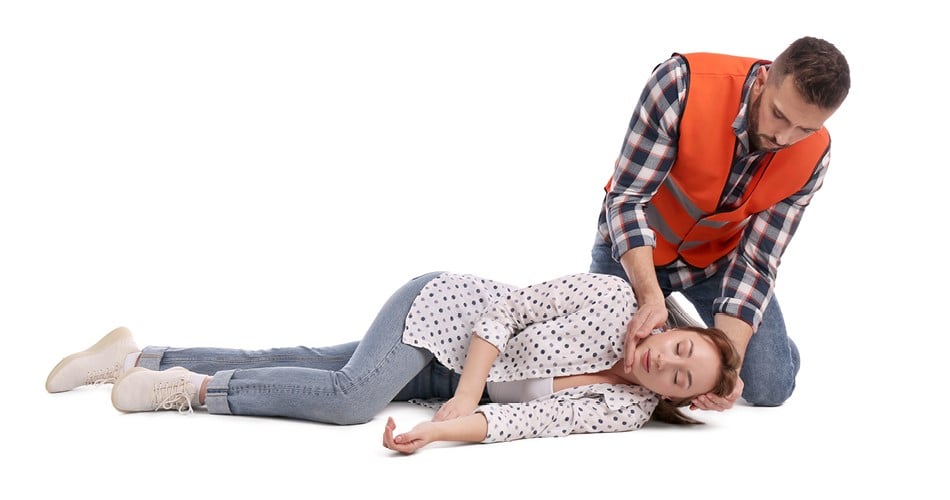 |
|
Breathing Look, listen and feel for no more than 10 seconds to assess breathing. If the individual is breathing normally, place them in the Recovery Position and monitor until paramedics arrive. However, if they are not breathing, start CPR immediately. |
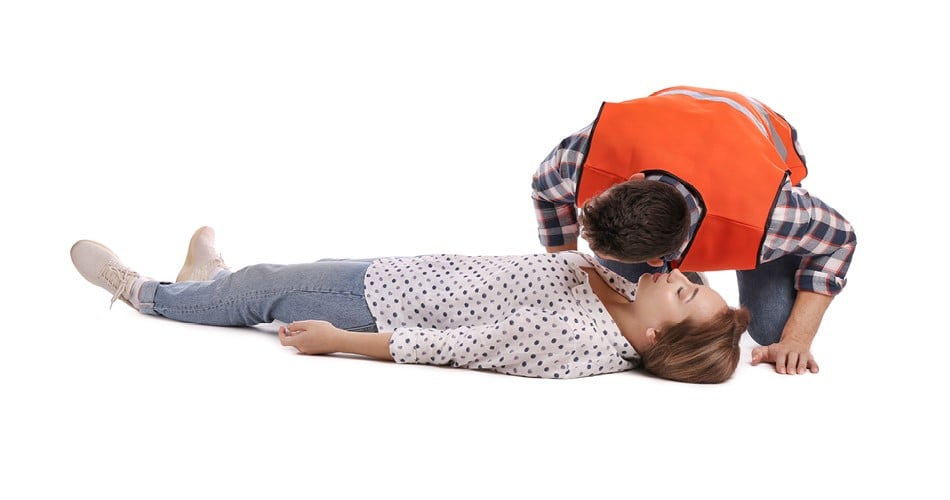 |
|
CPR (Cardiopulmonary Resuscitation) CPR is performed with the person laying face up. Place the heel of your hand on the centre of their chest and your other hand across the top of it. Press firmly to about a third of their chest – about 5 or 4cm for infants. Following 30 chest compressions, give 2 rescue breaths (if comfortable with mouth-to-mouth). To do this, tilt the person’s head back and lift their chin, pinch their nose and place your mouth over theirs. Adults should receive full breaths, shallow breaths for children and 2 puffs for infants. |
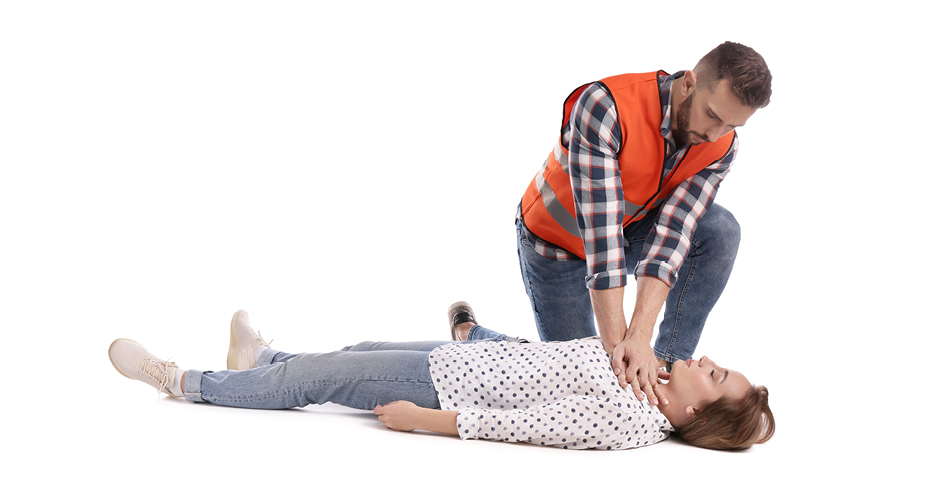 |
|
Defibrillator An Automatic External Defibrillator (AED) is a device used to ‘jump start’ the heart. It delivers electrical shocks to restore muscle contractions and return to a normal heart rhythm. Verbal instructions are built into most modern AEDs for ease of use. |
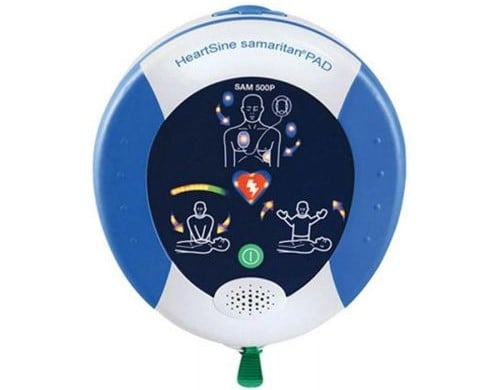 |
